Yukiko Ono, Deputy General Manager of IT & Suica Business Development Headquarters & Director of the Information Analysis Center, East Japan Railway Company
Railway company JR East offers Suica, a new form of infrastructure:
Through analyses of big data obtained from Suica, JR East explores possibilities to improve convenience and bring smiles to faces of everyone in Japan
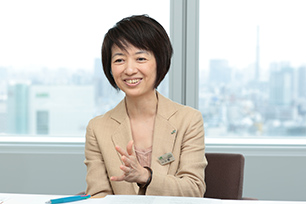
Yukiko Ono,
Deputy General Manager of IT & Suica Business Development Headquarters & Director of the Information Analysis Center, East Japan Railway Company
Born in Kanagawa in 1967. Joined East Japan Railway Company after graduating from the Department of Administration Engineering of the Faculty of Science and Technology in 1991. Having experienced the Transport & Rolling Stock Division at the Tokyo Branch Office, International Department, Safety Research Laboratory, and Management Planning Department (also serving for Frontier Service Development Center), serves today as Deputy General Manager of IT & Suica Business Development Headquarters, and director of the Information Analysis Center.
Presenting new services based on the analyses of Suica usage
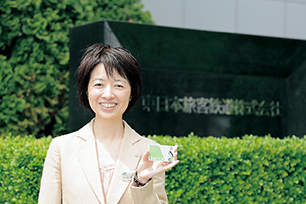
─ This spring, a new service was launched to allow reciprocal use of 10 different IC card tickets nationwide, from Hokkaido to Kyushu. Cards such as Suica of JR East and ICOCA of JR West can be used nationwide in the coverage area. Ms. Yukiko Ono is the Deputy General Manager of IT & Suica Business Development Headquarters of East Japan Railway Company (JR East) and is also the director of the Information Analysis Center. Suica has become very convenient as you can now use it across more than 140 public transportation systems nationwide.
Suica came into service in 2001. Because we used open technology platforms, the technology was applied not only by JR group companies but also by many railway and bus companies, and as a result Suica can be used reciprocally with other IC cards across the entire country. I’m pleased that it has become more convenient and customers are happy about it.
Suica started as a transportation IC card and could only be used as a train ticket originally, but in 2004, we added an electronic money function that allowed cardholders to shop with the card. Furthermore, as a result of our efforts to improve customer convenience, Suica has evolved into a multifunctional card, including such features as the ability to integrate Suica with credit cards and “Mobile Suica,” which utilizes the telecommunication and display functions of mobile phones.
My current job is to seek new possibilities for the card through analyses of big data based on all kinds of information we obtain from Suica so as to better serve our customers.
Since 2009, I have belonged to the IT & Suica Business Development Headquarters as a group leader of a project to promote the effective use of Suica data. Having eliminated all personal and private information of customers, we use strictly controlled data to understand and analyze customers’ behavior and trends by looking at the ways in which the card is used, such as which stations people get on and off at most and where they frequently shop.
For example, when we go through card data of “Suica & N’EX,” a combination of Suica and an express ticket from Narita Airport sold exclusively to customers from overseas, we can see which stations are more often used by international customers. We are able to infer many things by examining the data: for example, we can see that many customers stay overnight in Shinjuku as people get off there and get on trains the next morning and that many people go to Akihabara to go shopping as they get off there and then back on during the day. Interestingly, we also found out that many people go to Mitaka. When we looked into the reason why, we found out that many international customers seem to be headed to the Ghibli Museum there. Also, a surprising number of people visit Jiyugaoka and Kichijoji, maybe in search of stylish accessories. The locals may have firsthand knowledge of these things, but we are able to understand the situation by piecing together different pieces of data. Information we gain from these analyses is utilized when releasing information in brochures for international customers so that we can provide pertinent services to our customers that are based on hard facts rather than mere hunches or biased impressions.
─ A job that involves data collection, analysis, and utilization looks a little odd for a railway company, doesn’t it?
It really isn’t odd as a part of corporate activities in today’s world, but it may diverge from the image people have of a conventional railway company.
Before getting involved in the Suica project, I belonged to the Frontier Service Development Laboratory, where I would provide information and suggestions to rail lines and stations based on customer feedback. It is important for our business to flexibly meet customers’ needs and demands as times change. And so my role continues to be to make suggestions through the eyes of customers by looking objectively at our core business of operating trains. I do this by analyzing research on how we can enhance value along each railway line or what kind of branding strategy we should have for Suica in order to gain more trust and support.
─ Although Japanese National Railways was privatized and divided into seven smaller companies, JR East is still an enormous company. There is no doubt that it plays a key role in leading Japan’s transport infrastructure along with other JR companies. Because of this, we tend to think of the company as being conservative, but the company has been attracting a lot of attention for its flexible, forward-looking strategies such as Mobile Suica and development of “Eki-naka Shoppingu” (in-station shopping).
Although the company was privatized after being a nationally owned railway for so long, we still maintain the same profound awareness and commitment to playing a key role in providing social infrastructure and serving the public. If I may be so bold, I believe we can bring smiles to everyone in Japan if we can please our customers through work that is closely related to their daily lives.
Since childhood, I have always attempted things that I am not good at but am interested in
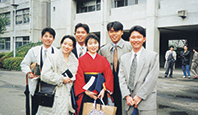
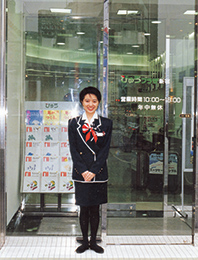
─ Please tell us why you proceeded to the Department of Administration Engineering of the Faculty of Science and Technology.
I lived in Hiyoshi until fifth grade, so I think that I had a sense of familiarity with Keio from an early age. I even took the entrance exams of Keio Chutobu Junior High School but failed and entered an all-girls’ school unaffiliated with Keio.
In high school, I took the science course though I was never really good at math or sciences and was probably better suited for the humanities. Even so, I have always had strong feelings to try things that I am not good at but am interested in, so without thinking much, I chose to proceed to a math department when taking university entrance exams. Unfortunately, I failed and had to spend another year preparing to enter university. The following year, I looked into different majors and felt an interest in administration engineering as it is deeply related to society, which is why I chose the Faculty of Science and Technology at Keio University.
Administration engineering is a field in which we design “connections between people and hardware” to serve society with a broad and comprehensive view, rather than to learn to develop or manufacture hardware. Unlike studies that require deep exploration of a single issue, we study a range of different topics, acquiring a general knowledge of science and technology and developing skills to deal with all kinds of problems from a scientific standpoint. This learning style really suited me, and I was able to spend four fulfilling years studying across a range of sciences.
I particularly enjoyed the lab work. For example, I remember one industrial engineering lab in which we had to figure the out the best manufacturing process to assemble a ballpoint pen quickly and efficiently. This was a typical theme for administration engineering. Also, in the computer programming classes at that time, we had to use punched cards, which may be unfamiliar to Keio students today. A single mistake in one of the cards would result in an error message, and we had a hard time dealing with them.
I feel that the Faculty of Science and Technology back then took the following stance toward its students: “Think for yourself and we will look after you.” I wasn’t aware of this as a student, but thinking back now, I guess this is Keio’s educational style of nurturing self-independence. Incidentally, I was recently encouraged to keep working hard when I reread Yukichi Fukuzawa’s Gakumon no Susume (“An Encouragement of Learning”). I took away the message that one should keep heading straight down the right path.
I belonged to the statistics laboratory of Assistant Professor Juichiro Takeuchi. Although I wasn’t really good at it, I chose statistics because again I wanted to try something that I am not good at but am interested in. My graduation research was on non-parametric statistics, but I remember I wasn’t satisfied with the final product. I regret that if I had studied a little harder, it might have helped me at my current place of work. As for college memories, I also remember visiting Prof. Takeuchi’s house with my peers and enjoying karaoke.
I did think about proceeding to graduate school but decided against it in the end. I guess I just couldn’t wait to enter the real world.
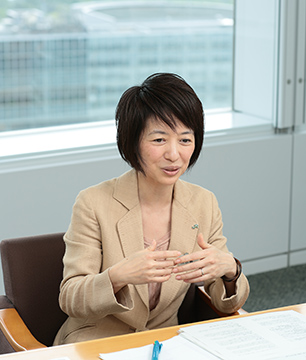
─ Among the graduates of the Faculty of Science and Technology of 1991, which is the year Ms. Ono graduated, about 45% proceeded to the Graduate School of Science and Technology. Today, almost 70% proceed to graduate school.
I guess it was a different time. Back then, it was the so-called bubble era and there were so many job offers that we could enter major companies upon Keio’s recommendation. However, I wanted to work in a new field rather than systems development, a highly demanded field for most companies. That is why I took the exam to work for JR East—because it had only been a few years since its privatization in 1987, and it seemed like something new might be in the works.
When I first joined the company, I received a lot of training, and did everything from station management to train driving and conducting. At first, it didn’t really feel like I had joined a railway company, but one day when I stood on a railway platform of Shibuya station wearing a uniform and holding a handflag, it struck me: “I really do work for the railroads.”
Keio University students today may have a hard time imagining that in those days there was no Suica, and even automatic ticket gates were still scarce, so I had to spend some of my training punching tickets at the ticket gate. Since you need to punch each and every ticket, my hands would get so numb I thought I had tendonitis. But I think training by experiencing things firsthand is really important. The different tasks that I experienced training and the customers that I met have become the underlying basis when I present new ideas based on information analyses.
─ What memories of Keio do you have other than those of your studies?
I didn’t belong to any circles because I was kind of rebellious and resolved not to be like one of the so-called glamorous “Keio Girls” (laughs). However, I did like to sing, so I attended a few practices of the Wagner Society Female Chorus. The teacher was a wonderful person, and I regret that I didn’t continue singing.
─ Finally, could you give a message to current Keio University students?
When I was a student at Keio, there was still the widespread slogan, “All Keio students must be able to swim.” At the time, physical education was a compulsory subject and I think that having been trained mentally and physically helped me when I started working. I heard that physical education is no longer a compulsory subject at the Faculty of Science and Technology, but I feel that students should still exercise in one way or another. A healthy mind and body has a positive effect not only for yourself but also for others around you and is a basic requirement to be able to do a good job.
Also, as I always say to my project members, I would like students to value their imagination and their ability to take action. These two things are inseparable from one another; before taking action, it is important to imagine how to make customers happy and how to act to produce effective results. Additionally, in order to imagine, you need to start by being informed about things, so I want students to develop a curiosity about everything and to visit different places and experience things firsthand. Though it may seem like a waste of time in the short term, I hope students try all kinds of things, even if it is doing things like going to see paintings or simply growing some vegetables.
─ Thank you very much.
*Position titles, etc., are those at the time of publishing.
